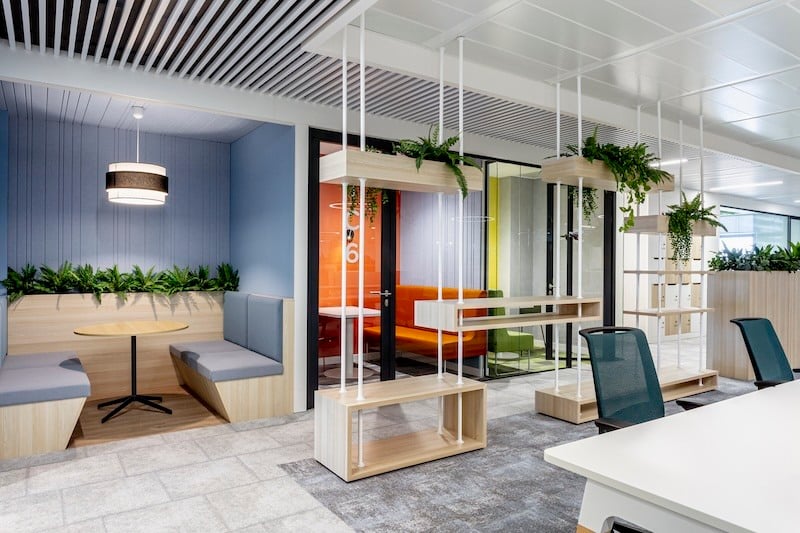Designing neuro-inclusive workplaces can involve both operational and physical changes to the work environment. As a result, the commercial interiors industry is also having to adjust and understand how to create workspaces that are inherently more inclusive, flexible and accommodating to a widening variety of neurological needs.
A recent Whitepaper entitled, ‘Designing a Neuro-Inclusive Workplace’, commissioned by Milliken & Company, examines the needs of neurodivergent employees, with a view to understanding the adaptations that companies can make to improve their work comfort, focus and efficiency. Given the sensory overwhelm typically (although not exclusively) experienced by neurodivergent people, most commonly with conditions such as ADHD, Autism and Dyslexia, the report considers its findings through the lens of the four primary senses of Smell, Sound, Sight and Comfort.
Why create neuro-inclusive workplaces?
Before we get into the ‘How’, it is worth considering for a moment the significance of the ‘Why?'. With a global population of up to 20% of people now considered to be neurodiverse, unemployment rates among this valuable talent pool are still woefully high and are thought to be eight times that of non-neurodivergent or ‘neurotypical’ people. Despite the very real opportunities that neurodivergent thinking can potentially bring to the workplace, a lack of understanding, until recently, of what a neuro-inclusive workplace should look like has held many companies back from making what can often be very simple and fundamental changes to their work environments. So, let’s dive into what can be done.
You may be interested to read our related blog 10 NEURODIVERISTY AT WORK STATISTICS THAT MIGHT SURPRISE YOU
1. SMELL: Designing it in and out of the neuro-inclusive workplace
Due to its close connection to the emotional and memory centre of the brain, smell is arguably one of our most powerful senses. While ‘scent scaping’ or designing smells into particular environments has been on the rise for retail, hotel and leisure spaces for quite a while, in the workplace, it is potentially underutilised.
 Research has shown how focus and performance can be improved by smelling coffee while accuracy is improved by the scent of lemon, jasmine and lavender.
Research has shown how focus and performance can be improved by smelling coffee while accuracy is improved by the scent of lemon, jasmine and lavender.
For some neurodiverse people, hypersensitivity to smell can be disruptive and intrusive, leading to anxiety, nausea and dizziness. In the workplace, deliberate smells such as air fresheners, and involuntary smells like the Volatile Organic Compounds (VOCs) commonly found in some paints, adhesives and furnishing materials, can be problematic.
How to manage smells
Here are some pointers on how best to manage smells when designing an inclusive workspace with neurodivergent employees in mind:
- For new builds, consider ventilation early in the design process and the proximity of working areas to those likely to emit strong smells such as kitchens, gyms and plant rooms.
- Ensuring VOCs are minimised for interior material specifications during a build or refurbishment will help to ensure that Indoor Air Quality is optimised.
- When using curated scents, creating an ‘escape space’ for those with particular hypersensitivities to smell should be made available. Avoid places such as corridors or stairwells where scent can build up.
- Microenvironments for scent can allow people to tailor their preferences – (keeping them in localised and restricted areas) - a positive scent for one person can be an overwhelming and triggering one for others.
- For larger organisations, designing refreshment stations that offer different options can be a deliberate way of curating varying degrees of positive scent stimulation.

2. SOUND: Start design with acoustics in mind
The great post-Covid office return has highlighted for many of us how the ‘office-buzz’ can in fact become an unwelcome distraction and ultimately have a negative impact on people’s ability to focus and concentrate.
Unwanted noise has been shown to cause a multitude of issues in the workplace, from stress and sleep disorders to hypertension and even cardiovascular disease. Where neurotypical brains are more easily able to filter out excessive sounds, for neurodivergent brains this can become extremely debilitating and draining of their cognitive resources.
Workplace variety and choice
Providing variety and choice by deliberately designing in more active/noisy zones and quieter/low-traffic ones for more intense, concentrated working is key.
Read our related blogs: MANAGING ACOUSTICS FOR THE NEURO-INCLUSIVE WORKPLACE and SPACE PLANNING FOR THE NEURO-INCLUSIVE WORKPLACE
3. SIGHT: What you see isn’t always what you get
Creating workspaces where everybody can feel welcome, where they belong and feel comfortable is at the heart of inclusive design. So, it’s important for employers to be aware when sensory overload is becoming an issue for its neurodiverse employees. Too many colours, textures, symbols, signs and patterns can cause anxiety, confusion and disconnection.
Manage visual stimulation levels IN THE WORKPLACE
When getting visual stimulation levels right for the neurodivergent brain there are three key areas to consider:
- Wayfinding is a multi-sensory activity. Depending on an individual’s processing preference, some will rely on visual cues, such as landmark shapes and colours, while others will rely more on signage with numbers, symbols and words. It’s important to cover all bases. More details ideas on this area can be found in our related SPACE PLANNING blog.
- Colour and Pattern are experienced differently depending on the way your brain processes them -and it’s not always the same. Colours can appear more vivid to those with hypersensitivity. For people with autism, reds, blues and yellows in their full intensity should be avoided. Décor with strong contrasts in pattern or texture can also be uncomfortable and overstimulating, whereas colours and textures found in nature can be calming and soothing. As a rule, neutral, muted palettes are generally found to be neuro-friendly for everyone.

TotalEnergies featuring Comfortable Concrete and Lightbox
- Lighting in the workplace for neurodivergent people is all about the ability to control it. Although well-being standards focus on the importance of proximity to windows and daylight, this can be variable depending on your location. Alternative spaces with controllable lighting can empower neurodivergent employees to choose a lighting level and source that best suits them. Generally, when it comes to fittings, LED lights are preferable to fluorescents, screens or blinds can help to reduce glare and shielding any flashing devices and equipment will make spaces more comfortable to work in.
4. COMFORT: A safe space where EVERYONE can thrive
Now more than ever, in our busy, high-tech., high-stimulus world of work, many of us are seeking spaces to recalibrate, decompress and escape. In the workplace, good communication is vital to recognising and understanding how and when employees need to take time out.
Educating the wider workforce and helping them to understand the particular needs of neurodivergent colleagues will also help to build a culture of understanding, promote confidence in using the right language to remove any awkwardness and will go a long way to fostering a mutually supporting environment.
The interviews carried out with neurodivergent employees as part of the research for the Whitepaper report, revealed some valuable insights into how comfortable and safe they felt at work. The trust that their companies placed in them as to how they chose to work was highly valued. Building flexible and open dialogue ultimately was a key first step in creating a successful neuro-inclusive workplace.
Those companies that recognise the business benefits of attracting and retaining diverse talent and therefore provide the right enabling environment, will be able to compete more effectively in a shrinking talent pool and support all employees to thrive.
 Lähi Tapiola Insurance featuring Artistic Liberties - Without Reserve
Lähi Tapiola Insurance featuring Artistic Liberties - Without Reserve
The Whitepaper referenced in this blog was produced in partnership with workplace design specialists Henigan Consulting Group and independent market research agency Sappio Research.
You may also be interested in booking on Milliken’s RIBA Approved CPD Seminar ‘Designing for Neuro-inclusive Workplaces: A Focus on Flooring’







